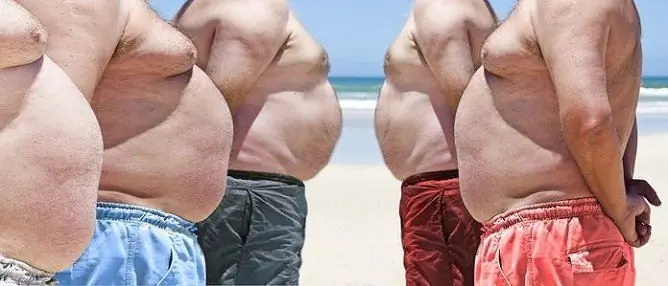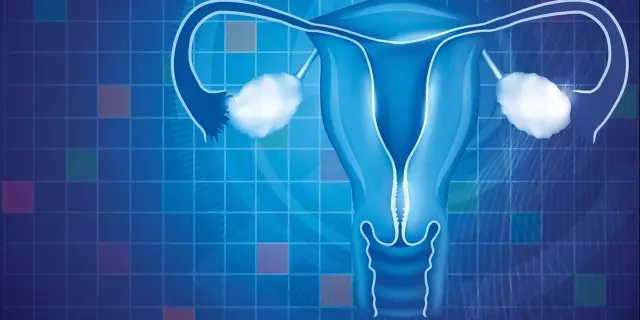- Author Rachel Wainwright [email protected].
- Public 2023-12-15 07:39.
- Last modified 2025-11-02 20:14.
Dihydrotestosterone in women and men: functions, reasons for increasing and decreasing
The content of the article:
- DHT functions in women and men
- DHT rate
- Decreased DHT levels
- When dihydrotestosterone is elevated
- Diagnosis of hormonal disorders
- How to normalize DHT levels
Dihydrotestosterone is one of the representatives of the androgen group, a biologically active form of the testosterone hormone, which is formed by the action of the 5-alpha reductase enzyme in target cells.

Excess dihydrotestosterone in men causes baldness
Dehydrotestosterone (DHT) is formed from free testosterone and androstenedione in androgen-dependent tissues. The main place of formation and secretion of testosterone is Leydig cells (interstitial cells of the testicles). The biosynthesis of the hormone is also carried out in the adrenal cortex. The testosterone conversion process is facilitated by the tissue enzyme 5-alpha reductase. Acting on testosterone in target cells (muscles, skin, adipose tissue), it adds two hydrogen atoms to the testosterone structure. Under the action of enzyme systems, the activity of testosterone increases, it begins to convert into 5α-dihydrotestosterone.
The testosterone metabolite is found in many tissues of the body (in the prostate gland, external genitals, seminal vesicles, some areas of the skin, hair follicles). Converted dehydrotestosterone has a more significant androgenic effect than its initial form - testosterone, according to a number of indicators its androgenic activity in peripheral tissues is 3-4 times higher.
DHT functions in women and men
The main functions of DHT in the male body are associated with the formation and development of the reproductive system and sexual characteristics. Dihydrotestosterone in men has the following effects:
- stimulates spermatogenesis;
- suppresses the secretion of luteinizing hormone in the anterior pituitary gland;
- affects the functional maturation of gonadotropic cells in the adenohypophysis;
- stimulates the development of the prostate gland and external genital organs in the prenatal period, promotes their growth in puberty;
- forms secondary sexual characteristics;
- regulates the structure and development of the skeletal system, the growth of muscle mass;
- has a stimulating effect on the nervous system;
- regulates libido;
- responsible for the production of sebum;
- affects the hair follicles, is responsible for sexual hair growth.
DHT is also produced in the female body. The main source of dihydrotestosterone production in women is the adrenal cortex, ovarian cells, conversion from precursors of steroid hormones in the liver, muscles, skin and adipose tissue.
Functions of DHT in the female body:
- affects carbohydrate, protein, water and fat metabolism;
- determines the development of the skeleton and skeletal muscles;
- regulates sweating;
- activates the sebaceous glands;
- forms libido.
DHT rate
The most significant increase in the level of dihydrotestosterone is noted in adolescence, the peak of its production falls on 25 years. With age, the secretion of the hormone gradually decreases.
Dihydrotestosterone norms:
- up to 10 years: 5-25 pg / ml in girls and 5-50 pg / ml in boys;
- from 10 to 12 years old: 24-450 pg / ml in girls, 5-50 pg / ml in boys;
- from 13 to 18 years old: 24-450 pg / ml for girls and 250-700 pg / ml for boys;
- from 18 to 50 years: 24-450 pg / ml for women and 250-990 pg / ml for men;
- from 50 years: 10-181 pg / ml for women, 250-700 pg / ml for men.
Deviations in DHT secretion can lead to serious disruptions in the activity of various body systems.
Decreased DHT levels
Most often, a lowered level of the hormone is observed in men after 30-40 years.
Reasons for a decrease in DHT levels in men
- obesity;
- diabetes;
- deficiency of 5-alpha-reductase;
- androgen deficiency;
- hypogonadism (insufficiency of the sex glands).
- chronic prostatitis;
- Morris syndrome (testicular feminization syndrome).
Symptoms of a decrease in DHT levels in men:
- fat deposits in the female type (thighs, buttocks);
- delayed sexual development in adolescents, disproportionate growth of the limbs;
- the development of a figure in female proportions;
- reduced size of the penis, its abnormal structure;
- slow growth of hair on the face, groin, armpits;
- depression, emotional lability;
- fast fatiguability;
- lack of muscle mass;
- impotence, decreased sex drive;
- reproductive disorders, changes in spermogram.
Pathologies of the pituitary gland, ovaries, adrenal glands, diseases accompanied by a deficiency of adipose tissue can lead to the development of androgen deficiency states in women. DHT deficiency in women is characterized by a decrease in muscle mass, mood lability, a tendency to depression, decreased libido, and a decrease in skin tone and thickness.
When dihydrotestosterone is elevated
An increased level of DHT in men may indicate the following disorders:
- adrenal tumor;
- tumors of the genital organs;
- benign and malignant tumors of the prostate gland;
- hypergonadism (excessive hormonal activity of the gonads);
- cardiovascular diseases.
Excess DHT can also be caused by taking medications that contain androgens.
Symptoms of increased DHT in men:
- baldness;
- acne;
- increased excitability;
- decrease in the size of the testicles;
- infertility.
Possible reasons for the increase in the content of the hormone in women:
- adrenal tumors;
- diabetes;
- androgen-producing tumors in the adrenal glands or ovaries;
- unhealthy diet, obesity;
- pathology of the hypothalamus;
- taking hormonal drugs.
Physiological increase or decrease in DHT is observed during puberty, pre- and postmenopausal women, during pregnancy, lactation.

An increase in dihydrotestosterone in women can cause acne
If DHT is elevated, it can give rise to many pathologies. Excessively high levels of DHT in women are characterized by the following symptoms:
- hirsutism;
- diffuse thinning of hair on the head;
- excessive sweating;
- coarsening of the voice;
- acne, seborrhea;
- male skeletal development;
- obesity;
- hypertrophy of the clitoris and labia;
- failure of the menstrual cycle, anovulation;
- infertility.
Diagnosis of hormonal disorders
Examination for suspected violation of DHT synthesis includes, in addition to the hormonal examination itself, the study of hereditary history, urological or gynecological examination, ultrasound, genetic analysis.
A blood sample for testing for the content of dihydrotestosterone is taken from a vein. The analysis is taken on an empty stomach, at least eight hours should pass from the last meal. It is allowed to drink water. On the eve of the study, it is necessary to exclude increased psycho-emotional and physical exertion, fatty foods, alcohol, smoking, ultrasound and X-ray examinations. Women are encouraged to measure DHT levels at the beginning of their menstrual cycle. To assess the androgenic status of the body, it is necessary to pass the analysis several times at regular intervals.
If it is necessary to exclude tumor processes, CT scan of the adrenal glands, brain and other organs is performed.
How to normalize DHT levels
The main method of treatment for disorders of DHT secretion is drug therapy. Specific drugs and the duration of the course of treatment are determined by the doctor.
A decrease in the level of dihydrotestosterone in clinical practice is carried out with the help of steroid and non-steroidal androgens. These drugs inhibit DHT synthesis or prevent it from binding to target cell receptors. With premature sexual maturation in male children, agents are used that can lower the secretion of hormones from the pituitary gland and hypothalamus. If dihydrotestosterone is elevated in women, drugs containing metformin and spironolactone are prescribed. With increased activity of 5-alpha-reductase, inhibitors of this enzyme are used.
If the deviation of the hormone level from the norm is associated with a tumor of the adrenal glands or testicles, surgical or radiation treatment of the neoplasm is necessary.
If the hormone level is low, hormone replacement therapy is prescribed.
In the case of functional disorders, it is possible to normalize the hormonal balance without medication by correcting lifestyle: sports, body weight correction, normalization of work and rest, rejection of bad habits. To some extent, a balanced diet can increase the level of androgens - the diet should be enriched with vitamins, trace elements and protein. It is important to avoid psychoemotional stress, since the cortisol released during stress inhibits the synthesis of male sex hormones.
YouTube video related to the article:

Anna Kozlova Medical journalist About the author
Education: Rostov State Medical University, specialty "General Medicine".
Found a mistake in the text? Select it and press Ctrl + Enter.






